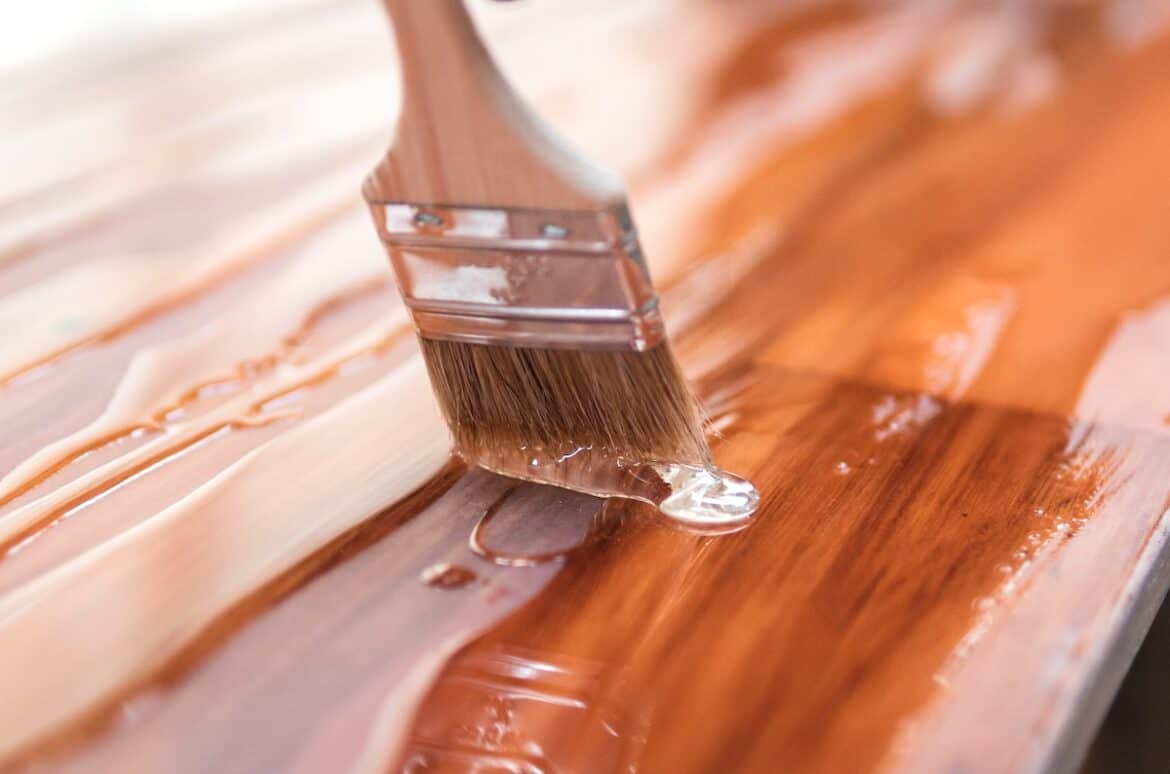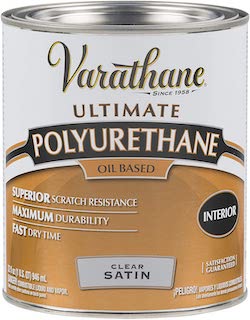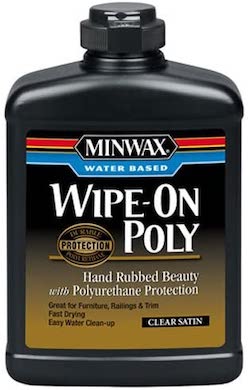There are many popular finishes and varnishes that you have to know about when learning woodworking. Each woodworking finish has its own unique qualities, with some being more durable than others.
Polyurethane and Danish oil are two different wood finishes that are often interchangeable. Polyurethane is a varnish that is highly versatile, and Danish oil is a lovely drying oil that can produce a protective coat for your natural wood.
But can you put polyurethane over danish oil? Yes, you can put polyurethane over Danish oil. However, it’s important to let the Danish oil dry completely first, or the polyurethane won’t be able to cling to the wood. Danish oil may take up to 24 hours to dry completely.
Let’s investigate the characteristics of these two types of wood finishes to better understand how to use them together for the best results possible.
What Is Polyurethane?
Polyurethane is a super strong and durable varnish that is formulated to resist water, abrasion, and impact. It’s made up of resin molecules that bond tightly to each other and to the wood it is applied to, forming a protective coat around the wood.
Basically, polyurethane is a liquid plastic that can be used in various forms until it completely dries. It is available in a wide range of colors and textures. There are several types of polyurethane that have different effects on your wood, including oil-based polyurethane and water-based polyurethane.
What Is Oil-Based Polyurethane?
Oil-based polyurethane is stronger and more effective than water-based polyurethane, so it is better if you want a more durable result, especially for outdoor furniture. Oil-based polyurethane tends to dry with an amber tint, so it can slightly affect the color of the wood, although not substantially.
Oil-based polyurethane dries to form a hard film over the wood, and it takes a while to cure, so if you want to apply several layers, you will need to wait for one coat to dry completely before applying another coat. You will need to clean your tools with mineral spirits after you’re done working as well to avoid buildup and residue hardening on your tools.
Compared to water-based polyurethane, oil-based types tend to have higher levels of volatile organic compounds (VOCs), which means it gives off more toxic fumes. This is a deterrence for most people when using oil-based polyurethane, especially if they have pets or children in their homes.
Because of the high VOC level, when using oil-based polyurethane, you will need to wear a respirator and work in a well-ventilated area. It’s also important to avoid touching with the oil-based surface when you work.
What Is Water-Based Polyurethane?
Compared to the oil-based type, water-based polyurethane is definitely more popular because it is safer and easier to use. Its quick drying time and low toxicity (low VOCs level) make it safe for amateurs to use. When you’re done, you can clean it up with soap and water, which is a big plus for those who aren’t professional woodworkers.
Water-based polyurethane has a milky color in the can, but it dries clear. You will need to apply a few coats of water-based Polyurethane to achieve a good level of protection, although its protection isn’t as strong as oil-based polyurethane. It is more recommended for indoor furniture.
Water-based oil-modified polyurethane is a great alternative to traditional oil-based polyurethanes since it is stronger than water-based polyurethane but less toxic and easier to clean up than oil-based types. You can consider using this option for things that need to withstand rough wear, such as flooring and outdoor furniture.
Application of Polyurethane
Depending on the type of polyurethane you have and the material you will need to use it on, you will need to work with a different application.
The most popular type of application is brush-on, which is ideal for flat surfaces where a durable film is needed. Brushes tend to work faster because they can hold a lot of finish and are designed to cover large areas at a time.
Wipe-on polyurethane is best used for areas where brushing can create drips, like crown molding. Wipe-on is a tricky application since it can form a thin and uneven coat, so it’s not recommended if you need a lot of coverage.
Nowadays, you can also buy spray-on polyurethane, which makes it easier to apply. This polyurethane is great for hard-to-reach surfaces, such as shutter louvers and chair spindles.
However, the spray-on type requires a sturdy hand and experience working with spray application. Otherwise, the finish can go on unevenly and drip in some areas if you’re too heavy-handed.
Finish of Polyurethane
You can buy polyurethane with a glossy, matte, or satin finish. You can choose the finish that you like since this doesn’t affect the polyurethane’s performance.
Use Of Polyurethane
Some polyurethane will specify whether it is designed for indoor or outdoor use. Most polys can be used indoors, but indoor-only polys should never be used outdoors due to their lack of additives that protect their exterior finishes from ultraviolet rays.
What Is Danish Oil?
Danish oil is a wood finishing oil that is often made from tung oil or polymerized linseed oil. There’s no specific formula for Danish oil, and depending on the manufacturer, you will have a different type of Danish oil. Generally, Danish oil is made by combining a drying oil and varnish together.
It is a hard-drying oil that can transform into a solid form when subjected to oxygen through a chemical reaction, creating a satin finish over whatever surface that it touches. It is commonly used as a wood primer before painting or wood varnish.
The hard satin finish also acts as a protective layer that protects the wood from water damage and other environmental factors. The layer of drying oil also adds a dark finish to the wood, without any glossy or slippery feeling.
As you can probably tell, Danish oil (and similar drying oil) can act as an effective sealant for natural wood. Unlike varnish, sealing the wood with Danish oil is quite simple. It is usually done by a brush or cloth, and you only need about three layers for it to work as an effective sealant.
Can I Put Polyurethane Over Danish Oil?
Both polyurethane and Danish oil are popular choices of sealant, but can you put one over the other?
The answer is yes. However, as with everything when it comes to finishing wood, you will need to let one layer dry completely before applying the next one. Polyurethane will add an extra layer of protection to the Danish oil finish, but if the oil isn’t completely dry, the Polyurethane won’t be able to grab onto the surface, which means it won’t work very well.
Depending on the Danish oil that you use, it will take anywhere from 4-24 hours to dry completely. If you are applying several layers of Danish oil, you should wait for each layer to dry completely before applying the next. After the last layer is dry, then you can apply the polyurethane varnish to complete the process.
Best Top Coat For Danish Oil
Danish oil is intended to be used as a wood finish on its own (there is varnish in the Danish oil already), meaning it can work just fine without a topcoat. Still, there’s no harm in adding another layer of protective film to protect your wood, especially if it is for rough, outdoor use.
If you want to add varnish on top of Danish oil, make sure that the layer of Danish oil is completely dry before you apply the varnish so that the application will work properly and you won’t have to wait forever for the varnish to dry.
Oil-Based Polyurethane
Oil-based Polyurethane can enhance the natural colors of the wood and add a rich hue, making the overall product looks more polished but still has a rustic feel. It is more durable but more affordable than other types of polyurethane, which means you can get your money’s worth easily.
However, oil-based polyurethane should really only be used by professionals since it has a high level of VOCs, which means it needs professional protective equipment, a spacious and well-ventilated working area, and mineral spirits to clean up. In addition, it takes longer to dry compared to other types of polyurethane.
Water-Based Polyurethane
Water-based polyurethane is definitely friendlier to amateurs or those who just want a non-toxic varnish option. Water-based polyurethane dries faster and is much easier to apply than the oil-based one, and it produces a clear finish that won’t change the color of the wood.
Since the Danish oil can produce a satin finish, using water-based polyurethane is more recommended since it won’t change the wood’s color and will allow the satin finish of the Danish oil to shine through.
Water-based polyurethane is non-toxic, so you can work without worrying about toxic fumes. However, the water-based polyurethane is definitely less durable and requires more maintenance compared to the oil-based type. If you are using water-based polyurethane, you will need to touch up the polyurethane after one or two years to maintain the protection.
You can always try the more expensive water-based oil-modified polyurethane option, which is non-toxic but archives the durability and quality of oil-based polyurethane. This option combines the best qualities of the other two types, so you should definitely consider it as a worthwhile candidate to finish your woodworking project.
For a quick guide to the various types of finishes, including polyurethane and danish oil, watch this video by Rag ‘n’ Bone Brown.
Up Next: Difference Between Polyurethane And Spar Urethane


